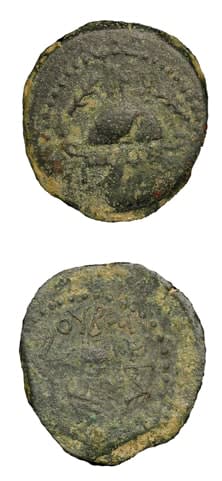Jewish Bronze Prutah of King Herod the Great, 40 BCE - 4 BCE
Bronze
C.10308
Obverse: Lebes over tripod; date to left, monogram to right. Reverse: Military helmet, star above, palm to left and right. The helmet on the reverse of this type has been...
Obverse: Lebes over tripod; date to left, monogram to right.
Reverse: Military helmet, star above, palm to left and right.
The helmet on the reverse of this type has been the subject of much research. Initially thought to be a vessel (Madden 1864) others (Kindler 1974) referred to it as a thymaterion (incense burner), but today’s experts (Meshorer and Hendin) now believe it to be a helmet. Its confirmation to be a helmet was presented by Hendin in the Israel Numismatic Journal Vol.11 in which he showed that, through the analysis of a superb specimen, there was a wreath on the helmet which included a large leaf as a central device. Thus he concluded that the object is a soldier’s helmet with a wreath, cheek pieces and straps. Leaves on helmets were a suitable symbol and design motif at this time as Herod I did not depict human images on any of his coins.
Reverse: Military helmet, star above, palm to left and right.
The helmet on the reverse of this type has been the subject of much research. Initially thought to be a vessel (Madden 1864) others (Kindler 1974) referred to it as a thymaterion (incense burner), but today’s experts (Meshorer and Hendin) now believe it to be a helmet. Its confirmation to be a helmet was presented by Hendin in the Israel Numismatic Journal Vol.11 in which he showed that, through the analysis of a superb specimen, there was a wreath on the helmet which included a large leaf as a central device. Thus he concluded that the object is a soldier’s helmet with a wreath, cheek pieces and straps. Leaves on helmets were a suitable symbol and design motif at this time as Herod I did not depict human images on any of his coins.
